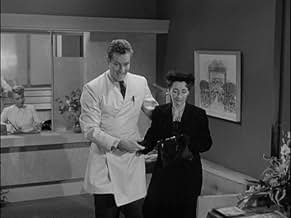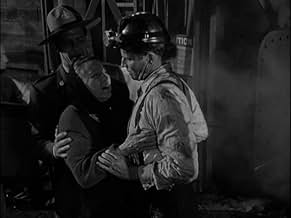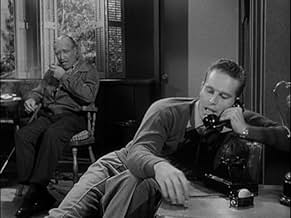IMDb RATING
5.8/10
1.1K
YOUR RATING
A doctor returning from the Korean War to his hometown in Pennsylvania must choose what next to do with his life.A doctor returning from the Korean War to his hometown in Pennsylvania must choose what next to do with his life.A doctor returning from the Korean War to his hometown in Pennsylvania must choose what next to do with his life.
Philip Ahlm
- Minor Role
- (uncredited)
Elsie Baker
- Mrs. Olzoneski
- (uncredited)
Mary Benoit
- Party Guest
- (uncredited)
Featured reviews
Maybe if John Garfield had been cast instead of Charlton Heston (who looks and moves like Frankinstein's monster here); and if the producers (writers? director?) had not backed away from the mine safety, health, and company criminal negligence theme that packs a punch in the first ten minutes of the movie.
Bad for Each Other (1953)
Charlton Heston gets a bad rap sometimes--maybe that's what you expect after "Planet of the Apes"--but here he is the charming, confident, larger than life young man that made him famous. Yes, it's a B-movie, but it's a very strong performance for Heston and he is surrounded by a cast that is decent (Lizabeth Scott not at her best, which is saying a lot) to terrific (Ray Collins as the big business power guy he plays so well). The "business" at the center is a coal mine in a small Pennsylvania town, and Heston plays a doctor, Tom Owen, getting out of the military in a pseudo-noir kind of echo. Owen's dilemma is a worldly one--whether to doctor rich old women with frivolous pains or to work for the miners in their lower class afflictions.
And it is Lizabeth Scott, a pampered (and unabashedly pampered) rich girl who snags our hero, and so against his initial instinct Heston goes the rich and lazy way. But of course the coal mining town is all around him, and reminders pop up now and then. It's a great problem for a movie, and it's worked out with fairly predictable logic, so there is nothing to really fault here. Except that very predictability. Even Scott is a bit bland, not really getting to run her coolness to true ice. Some of the side characters are well developed, surprisingly (a "good" doctor untainted by money and an old woman who is wiser than she lets on at first), and director Irving Rapper (who should have been a music star in the 1990s with a name like that) makes it pop pretty well.
The less than sterling reputation of this movie is unwarranted, but it may be a result of higher expectations than this kind of movie deserves. Yes, the plot is boilerplate stuff, but so are half the movie plots out there. And Heston is sort of terrific. Yes, he plays a type, and he doesn't give the angst some other actor might, but I don't think the character, Dr. Owen, was an angst-y kind of guy. The way he wrestles with things is believable.
The cinematography by Franz Planer is better than I'd expected (the name didn't ring a bell) and there are small sterling moments, the camera moving around a group of people at a table, or across a wrought iron screen as the two leads start to hit it off. Nice stuff. The title is wrong, by the way--it's only Scott's character who is bad for the doctor, not the other way around. She's not about to be affected by anyone, especially a handsome young ex-GI who is such easy prey.
Charlton Heston gets a bad rap sometimes--maybe that's what you expect after "Planet of the Apes"--but here he is the charming, confident, larger than life young man that made him famous. Yes, it's a B-movie, but it's a very strong performance for Heston and he is surrounded by a cast that is decent (Lizabeth Scott not at her best, which is saying a lot) to terrific (Ray Collins as the big business power guy he plays so well). The "business" at the center is a coal mine in a small Pennsylvania town, and Heston plays a doctor, Tom Owen, getting out of the military in a pseudo-noir kind of echo. Owen's dilemma is a worldly one--whether to doctor rich old women with frivolous pains or to work for the miners in their lower class afflictions.
And it is Lizabeth Scott, a pampered (and unabashedly pampered) rich girl who snags our hero, and so against his initial instinct Heston goes the rich and lazy way. But of course the coal mining town is all around him, and reminders pop up now and then. It's a great problem for a movie, and it's worked out with fairly predictable logic, so there is nothing to really fault here. Except that very predictability. Even Scott is a bit bland, not really getting to run her coolness to true ice. Some of the side characters are well developed, surprisingly (a "good" doctor untainted by money and an old woman who is wiser than she lets on at first), and director Irving Rapper (who should have been a music star in the 1990s with a name like that) makes it pop pretty well.
The less than sterling reputation of this movie is unwarranted, but it may be a result of higher expectations than this kind of movie deserves. Yes, the plot is boilerplate stuff, but so are half the movie plots out there. And Heston is sort of terrific. Yes, he plays a type, and he doesn't give the angst some other actor might, but I don't think the character, Dr. Owen, was an angst-y kind of guy. The way he wrestles with things is believable.
The cinematography by Franz Planer is better than I'd expected (the name didn't ring a bell) and there are small sterling moments, the camera moving around a group of people at a table, or across a wrought iron screen as the two leads start to hit it off. Nice stuff. The title is wrong, by the way--it's only Scott's character who is bad for the doctor, not the other way around. She's not about to be affected by anyone, especially a handsome young ex-GI who is such easy prey.
Bad for Each Other ([BFEO) is an obscure modestly regarded film that Charlton Heston made as a Paramount contract employee on loan out to Columbia at the dawn of his cinematic acting career. It was preceded by his excellent western movie Arrowhead, and immediately followed by his well regarded unusual adventure film The Naked Jungle (all made in 1953). BFEO (unlike Arrowhead and The Naked Jungle) is a contemporary social melodrama with a story set in a coal mining suburb of Pittsburgh. Heston is a recently discharged MD who is faced with the usual dilemma such folks often have to deal with: should he be a capitalist and seek out the most lucrative opportunity to practice medicine or a humanitarian and apply his skills to help the less fortunate people in his community? This is the issue at the heart of BFEO.
Heston is conflicted and somewhat self-righteous as he comes to grips with his personal values and convictions. Complicating matters are those individuals who are the major influences in his life: a predatory society woman who has set her sights on him (Lizabeth Scott), an idealistic nurse (Dianne Foster), a young doctor who believes that fulfillment can only come from assisting the poor (Arthur Franz), an older doctor who has a small practice in the mining community (Rhys Williams) and a.mother who believes that he should stay and work in his home town (Mildred Dunnock).
BFEO has a plot that contains echoes from other films: So Big (1932), The Citadel (1938), Not as a Stranger (1955), How Green Was My Valley (1941) and The Best Years of Our Lives (1948). It was directed in workmanlike fashion by veteran Irving Rapper, and the acting is consistently interesting. Heston is sincere, stalwart and occasionally naive in his troubled soul-searching, Scott (cast against type) is a spirited if not entirely credible rich young matron, Foster is a beautiful and appealing supporting player, Franz (a successful TV actor at the time) is quite engaging in his idealistic role, Williams is strong and dependable as always and Dunnock makes a most realistic mother trying to help her son with his choices in life. This excellent cast lifts BFEO from being a routine somewhat derivative entertainment, and the film certainly deserves a fresh reconsideration by a modern audience.
Heston is conflicted and somewhat self-righteous as he comes to grips with his personal values and convictions. Complicating matters are those individuals who are the major influences in his life: a predatory society woman who has set her sights on him (Lizabeth Scott), an idealistic nurse (Dianne Foster), a young doctor who believes that fulfillment can only come from assisting the poor (Arthur Franz), an older doctor who has a small practice in the mining community (Rhys Williams) and a.mother who believes that he should stay and work in his home town (Mildred Dunnock).
BFEO has a plot that contains echoes from other films: So Big (1932), The Citadel (1938), Not as a Stranger (1955), How Green Was My Valley (1941) and The Best Years of Our Lives (1948). It was directed in workmanlike fashion by veteran Irving Rapper, and the acting is consistently interesting. Heston is sincere, stalwart and occasionally naive in his troubled soul-searching, Scott (cast against type) is a spirited if not entirely credible rich young matron, Foster is a beautiful and appealing supporting player, Franz (a successful TV actor at the time) is quite engaging in his idealistic role, Williams is strong and dependable as always and Dunnock makes a most realistic mother trying to help her son with his choices in life. This excellent cast lifts BFEO from being a routine somewhat derivative entertainment, and the film certainly deserves a fresh reconsideration by a modern audience.
Charlton Heston stars as doctor and retired Army colonel Tom Owen. He has returned to his home turf, the small mining town of Coalville. The miners hate him because of something his now-dead brother did years earlier, but the upper crust of Coalville society are excited by the new hunky doctor's arrival. With the help of rich man-eater Helen (Lizabeth Scott), Tom is soon in private practice, catering to the lonely and wealthy women of Coalville. His nurse Joan (Dianne Foster) wants to practice the "right kind of medicine", but is Tom only interested in a fast buck and a good time?
This was just terrible, badly written and even more poorly acted. Heston wins the prize for "Worst in Show", delivering his lines in the most grating, hammy way imaginable, while also exhibiting some of the most overwrought physical business I've ever seen on the screen. The script never fails to tell you how wonderful Heston's Tom Mason is supposed to be, even if we are given scant evidence of it. Every woman falls at his feet, while every man is either in awe or angry with jealousy. Some may enjoy how the movie moves from just bad to amusingly camp, while others will just hit the "stop" button and find something better to do with their remaining time.
This was just terrible, badly written and even more poorly acted. Heston wins the prize for "Worst in Show", delivering his lines in the most grating, hammy way imaginable, while also exhibiting some of the most overwrought physical business I've ever seen on the screen. The script never fails to tell you how wonderful Heston's Tom Mason is supposed to be, even if we are given scant evidence of it. Every woman falls at his feet, while every man is either in awe or angry with jealousy. Some may enjoy how the movie moves from just bad to amusingly camp, while others will just hit the "stop" button and find something better to do with their remaining time.
(1953) Bad For Each Other
DRAMA
Co-written and directed by Irving Rapper that opens with a colonel, Thomas Owen (Charlton Heston) or Tom for short coming back to a mining town, Coalville and finds out his brother had long been past, that he may not be on the up and up as told by mother, Mrs. Mary Owen (Mildred Dunnock). So he then goes and visits the owner of the coal mine, Dan Reasonover (Ray Collins) and finds out that he stole and owed money to the coal mining comp as well as the owner Reasonover. During this, Dan Reasonover's daughter, Helen Curtis then becomes infatuated by him and tries to convince him to become a doctor for the upper class as a profession and drop from being one for the army. He does, and at the same time falls for Helen and let's her to drop what he wanted to do to become an associate for Dr. Homer Gleeson (Lester Matthews). And while he is in love with Helen, both Tom's own mother as well as Helen's dad disapproves of the match once he proposes to her.
The dilemma unfolds when Tom decides to break ethic rules by letting his boss Dr. Homer Gleeson to take full credit for a surgery he had done, forcing the nurse he had recently hired and respects to move to quit working for him and work for a much smaller clinic for the workers of Coalville.
It is kind of odd, this movie was selected to be shown on TCM Eddie Muller's Noir Alley when the overall experience is more drama than noir. And upon listening to Eddie Muller both from the introduction and afterward, I do not recall, why he thought this was film noir as their was no murder involve at all, but just some dilemmas.
Co-written and directed by Irving Rapper that opens with a colonel, Thomas Owen (Charlton Heston) or Tom for short coming back to a mining town, Coalville and finds out his brother had long been past, that he may not be on the up and up as told by mother, Mrs. Mary Owen (Mildred Dunnock). So he then goes and visits the owner of the coal mine, Dan Reasonover (Ray Collins) and finds out that he stole and owed money to the coal mining comp as well as the owner Reasonover. During this, Dan Reasonover's daughter, Helen Curtis then becomes infatuated by him and tries to convince him to become a doctor for the upper class as a profession and drop from being one for the army. He does, and at the same time falls for Helen and let's her to drop what he wanted to do to become an associate for Dr. Homer Gleeson (Lester Matthews). And while he is in love with Helen, both Tom's own mother as well as Helen's dad disapproves of the match once he proposes to her.
The dilemma unfolds when Tom decides to break ethic rules by letting his boss Dr. Homer Gleeson to take full credit for a surgery he had done, forcing the nurse he had recently hired and respects to move to quit working for him and work for a much smaller clinic for the workers of Coalville.
It is kind of odd, this movie was selected to be shown on TCM Eddie Muller's Noir Alley when the overall experience is more drama than noir. And upon listening to Eddie Muller both from the introduction and afterward, I do not recall, why he thought this was film noir as their was no murder involve at all, but just some dilemmas.
Did you know
- TriviaAccording to December 1950 articles in The Hollywood Reporter and the Los Angeles Times, producer Hal B. Wallis purchased the rights to the novel before it was published for $100,000 ($1.3M in 2024). Wallis intended the leads to be Burt Lancaster and Patricia Neal and that the project was to be filmed at Paramount. It never got off the ground, and Wallis ended up selling the rights to Columbia in early 1953.
- GoofsThe beginning scenes of movie show coal mine operations in Coalville, PA. The railroad caboose was from ATSF (Atchison, Topeka, and Santa Fe). That railroad never had operations in Pennsylvania.
- Quotes
Dr. Tom Owen: [on the phone with his wife] Oh, I'm interviewing nurses, of course... Don't be silly, darling - of course she'll be fat and ugly. I do insist on good legs, though.
- How long is Bad for Each Other?Powered by Alexa
Details
- Release date
- Country of origin
- Language
- Also known as
- Bad for Each Other
- Filming locations
- California, USA(Coalville)
- Production company
- See more company credits at IMDbPro
- Runtime
- 1h 23m(83 min)
- Color
Contribute to this page
Suggest an edit or add missing content



































